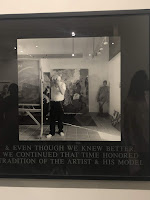Jenna Arvelo
When delving into Judith Howard's 'Social Psychology of Identities', one comes to realize just how multi layered and rich ones' identity actually is; and more interestingly, how this accumulation of layers began to fold on top of one another. When speaking of the construction of ones' identity, you must take into account the many facets of identity that are adopted or inherited by both societal conditioning and the necessity of acknowledging identities that reside on the intersections of other identity categories. With this being acknowledged, one realizes that many individuals reside between the grey areas of identity that aren't widely represented or expressed to the whole of the culture.
To construct an identity is to distinguish the many layers within one's' own sense of identity. Howard exemplifies this in her writings, emphasizing the cognitive and physical contributions to self and self-identity; explaining in detail the role of group identity, cognitive processes of identity, racial identity, sexual and gender identity, and a few of the many that make up the whole of an individual to which I would consider the 'political self'', which could or couldn't be interchangeable with functions of the inner self depending on the individual. She goes on to imply how the concept of identity is even now ever expanding and evolving with time and societal change.
Pertaining to our museum visit, the modes in which one navigates through everyday life has an enormous impact on how one would identify, interact and internalize the world around them. When visiting the Montclair museum, it felt as if these collective personal realities were being reflected back through various expressions based on the artists' preference of medium. It was both exciting and daunting seeing their reflections of themselves mirroring back at me; better yet back at the collective of individuals whom are ignorant to their realities. Portraiture in particular strikes a chord with me even within my own practice as a working artist. Whether it be a self portrait or the portraiture of others, I think the stand in of the physical self is an interesting act of presenting oneself of the self of another as a means of self acceptance, defiance, expression, an act of the political self and or merely to induce more representation for minority groups. The need to express self was evident within this exhibition; it was as beautiful as it was complex.
Jack Whitten is the only artist of the five I chose that paints non-representationally. Whitten's piece in this exhibition caught my attention unexpectedly (it was tucked in a corner and I hadn't noticed it immediately). I was magnetically drawn to the piece's texture and gradient and how the tiles overlapped and interacted with one another. The wall text gave some background as to the core themes running in Whitten's practice; which were themes surrounding ethnic and cultural identity. This specific piece titles 'Bessamer Boogie' made in 1993, is an abstracted painting of a historical event of Nelson Mandela's presidential victory in South Africa. Yet when gazing into the soul of this painting; its physicality, its density and richness; one can help but being enveloped into the actual experience of a this piece. Whitten, in a way alleviated the burdens and limitations of dealing with representational blackness; he rather turns it into an experienced impression of the feeling of pride in one's blackness. Which in my opinion freed him from the burden of appealing to only one facet of what being a multilayered artist is that just happens to be black.
 |
| Jack Whitten ‘Bessamer Boogie’ 1993 |
Alice Neel being a favorite of mine, remains one of the best portraitists I’ve yet to see. Neel draws upon the
Carrie Mae Weems ‘Framed by Modernism’ 1997
|
 |
| Alice Neel ‘Isabel Bishop’ 1974 |
Kehinde Wiley's painting was particularly exciting to discover in the exhibition. I think his work is especially relevant when discussing both cultural and racial identity. Within his portraits, Wiley uses the tool of portraiture to change the imagery surrounding African American males, while more notably inserting black bodies in traditionally European styles of portraiture. While Wiley efforts to reconnect with the cultural and historical heritage to Africa, he is also using these ancient mediums of patriarchy to both reclaim and rewrite a lost epistemology by the hands of Eurocentrism. So to regards to constructing identity, I believe Wiley's defiant method is one of reclaiming and re-establishing a lost cultural identity; to create imagery that both celebrates and immortalize black figures in a way that has been neglected throughout the history of art. To be depicted not as embellishment or as extras in the background, yet as focal individuals with grace, dignity and regal presence. Wiley's painting was one of the last id seen in the exhibition; yet it left me on a good note pondering how I've come to identify with my heritage, and how I could possibly make those ties stronger through my own art making or physically traveling back to my father's homeland in Haiti. The exhibition was worth while and I got to see works I wasn't expecting to see at all. Overall I think the construction of identity is such a fluid entity in itself that I've yet to even define myself within my own practice. Seeing how diverse each of these artists have come to approach themselves and the world around them leaves me to think that I may be on the right track.
  |
| Lorna Simpson 'Coiffure' 1991 & Kehinde Wiley "Matar Mbaye (Study 1), 2007 |

No comments:
Post a Comment